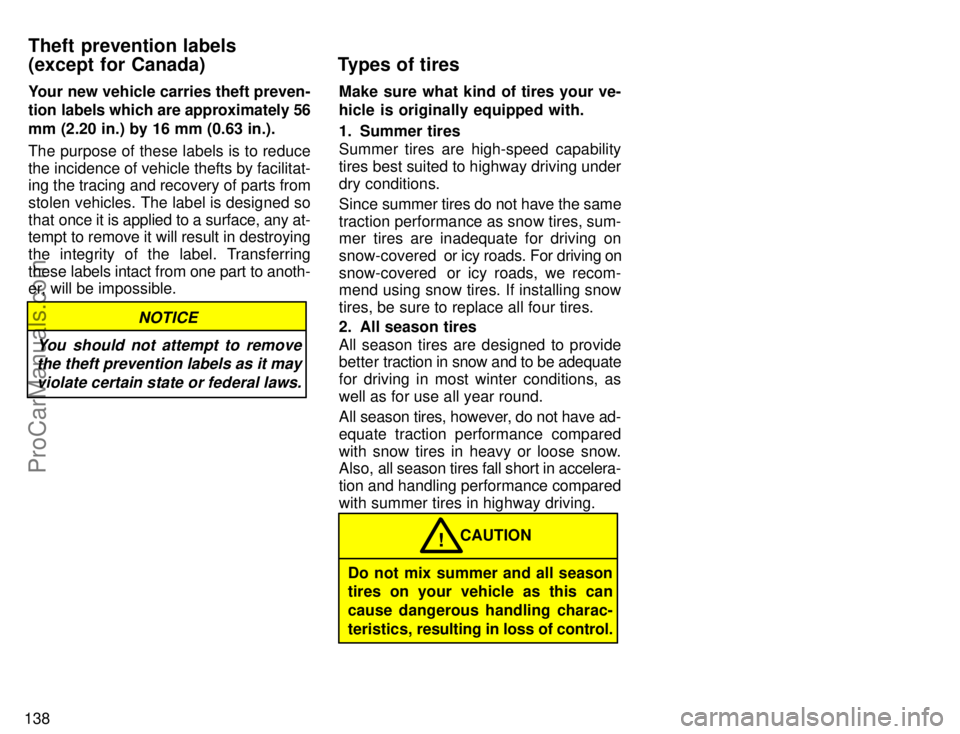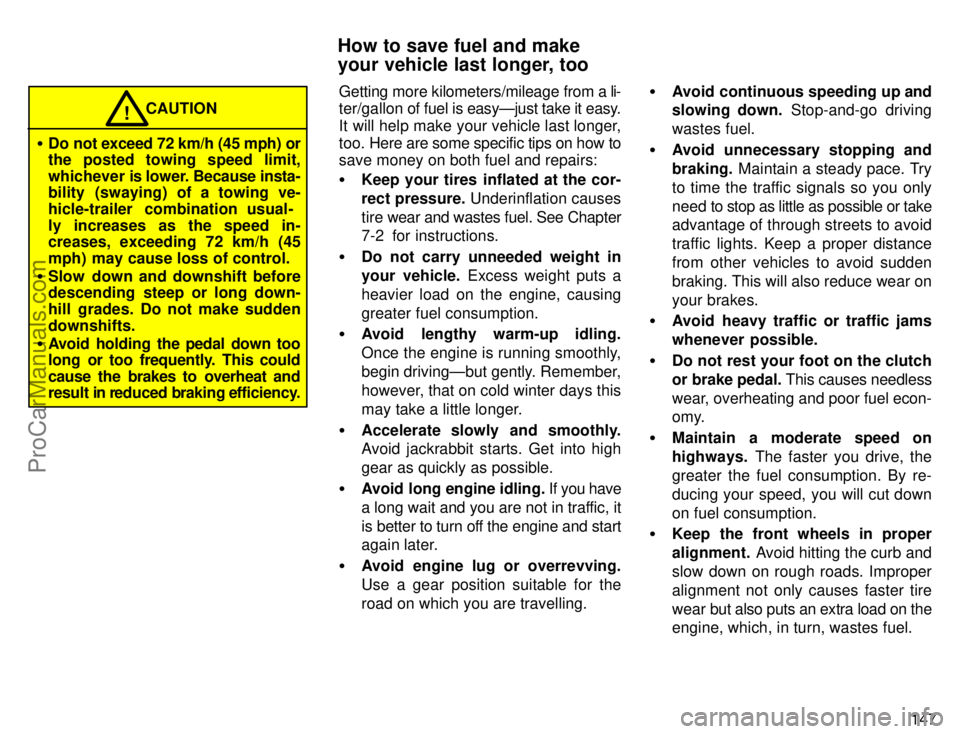Page 144 of 226

138Your new vehicle carries theft preven-
tion labels which are approximately 56
mm (2.20 in.) by 16 mm (0.63 in.).
The purpose of these labels is to reduce
the incidence of vehicle thefts by facilitat-
ing the tracing and recovery of parts from
stolen vehicles. The label is designed so
that once it is applied to a surface, any at-
tempt to remove it will result in destroying
the integrity of the label. Transferring
these labels intact from one part to anoth-
er, will be impossible.
NOTICE
You should not attempt to remove
the theft prevention labels as it may
violate certain state or federal laws.
Make sure what kind of tires your ve-
hicle is originally equipped with.
1. Summer tires
Summer tires are high-speed capability
tires best suited to highway driving under
dry conditions.
Since summer tires do not have the same
traction performance as snow tires, sum-
mer tires are inadequate for driving on
snow-covered or icy roads. For driving on
snow-covered or icy roads, we recom-
mend using snow tires. If installing snow
tires, be sure to replace all four tires.
2. All season tires
All season tires are designed to provide
better traction in snow and to be adequate
for driving in most winter conditions, as
well as for use all year round.
All season tires, however, do not have ad-
equate traction performance compared
with snow tires in heavy or loose snow.
Also, all season tires fall short in accelera-
tion and handling performance compared
with summer tires in highway driving.
CAUTION!
Do not mix summer and all season
tires on your vehicle as this can
cause dangerous handling charac-
teristics, resulting in loss of control.
Theft prevention labels
(except for Canada) Types of tires
ProCarManuals.com
Page 147 of 226

141
CAUTION!
�Before driving off, make sure that
the parking brake is fully released
and the parking brake reminder
light is off.
�Do not leave your vehicle unat-
tended while the engine is run-
ning.
�Do not rest your foot on the brake
pedal while driving. It can cause
dangerous overheating, needless
wear, and poor fuel economy.
�To drive down a long or steep hill,
reduce your speed and downshift.
Remember, if you ride the brakes
excessively, they may overheat
and not work properly.
�Be careful when accelerating, up-
shifting, downshifting or braking
on a slippery surface. Sudden ac-
celeration or engine braking could
cause the vehicle to spin or skid.
�Do not drive in excess of the speed
limit. Even if the legal speed limit
permits it, do not drive over 140
km/h (85 mph) unless your vehicle
has high-speed capability tires.
Driving over 140 km/h (85 mph)
may result in tire failure, loss of
control and possible injury. Be
sure to consult a tire dealer to de-
termine whether the tires on your
vehicle are high-speed capability
tires or not before driving at such
speeds.
�Do not continue normal driving
when the brakes are wet. If they are
wet, your vehicle will require a lon-
ger stopping distance, and it may
pull to one side when the brakes
are applied. Also, the parking
brake will not hold the vehicle se-
curely.Make sure you have ethylene-glycol
antifreeze in the radiator.
Do not use alcohol type antifreeze.
NOTICE
Check the condition of the battery and
cables.
Cold temperatures reduce the capacity of
any battery, so it must be in top shape to
provide enough power for winter starting.
Chapter 7-3 tells you how to visually in-
spect the battery. Your Toyota dealer and
most service stations will be pleased to
check the level of charge.
Make sure the engine oil viscosity is
suitable for the cold weather.
See Chapter 7-2 for recommended vis-
cosity. Leaving a heavy summer oil in your
vehicle during winter months may cause
harder starting. If you are not sure about
which oil to use, call your Toyota dealerÐ
he will be pleased to help.
Keep the door locks from freezing.
Squirt lock de-icer or glycerine into the
locks to keep them from freezing. To open
a frozen lock, try heating the key before in-
serting it.
Winter driving tips
ProCarManuals.com
Page 153 of 226

147
CAUTION!
�Do not exceed 72 km/h (45 mph) or
the posted towing speed limit,
whichever is lower. Because insta-
bility (swaying) of a towing ve-
hicle-trailer combination usual-
ly increases as the speed in-
creases, exceeding 72 km/h (45
mph) may cause loss of control.
�Slow down and downshift before
descending steep or long down-
hill grades. Do not make sudden
downshifts.
�Avoid holding the pedal down too
long or too frequently. This could
cause the brakes to overheat and
result in reduced braking efficiency.Getting more kilometers/mileage from a li-
ter/gallon of fuel is easyÐjust take it easy.
It will help make your vehicle last longer,
too. Here are some specific tips on how to
save money on both fuel and repairs:
�Keep your tires inflated at the cor-
rect pressure. Underinflation causes
tire wear and wastes fuel. See Chapter
7-2 for instructions.
�Do not carry unneeded weight in
your vehicle. Excess weight puts a
heavier load on the engine, causing
greater fuel consumption.
�Avoid lengthy warm-up idling.
Once the engine is running smoothly,
begin drivingÐbut gently. Remember,
however, that on cold winter days this
may take a little longer.
�Accelerate slowly and smoothly.
Avoid jackrabbit starts. Get into high
gear as quickly as possible.
�Avoid long engine idling. If you have
a long wait and you are not in traffic, it
is better to turn off the engine and start
again later.
�Avoid engine lug or overrevving.
Use a gear position suitable for the
road on which you are travelling.�Avoid continuous speeding up and
slowing down. Stop-and-go driving
wastes fuel.
�Avoid unnecessary stopping and
braking. Maintain a steady pace. Try
to time the traffic signals so you only
need to stop as little as possible or take
advantage of through streets to avoid
traffic lights. Keep a proper distance
from other vehicles to avoid sudden
braking. This will also reduce wear on
your brakes.
�Avoid heavy traffic or traffic jams
whenever possible.
�Do not rest your foot on the clutch
or brake pedal. This causes needless
wear, overheating and poor fuel econ-
omy.
�Maintain a moderate speed on
highways. The faster you drive, the
greater the fuel consumption. By re-
ducing your speed, you will cut down
on fuel consumption.
�Keep the front wheels in proper
alignment. Avoid hitting the curb and
slow down on rough roads. Improper
alignment not only causes faster tire
wear but also puts an extra load on the
engine, which, in turn, wastes fuel.
How to save fuel and make
your vehicle last longer, too
ProCarManuals.com